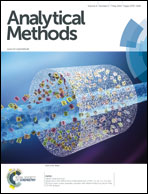Determination of selenium in soil samples using high-resolution continuum source graphite furnace atomic absorption spectrometry and direct solid sample analysis
Abstract
A method has been developed for the determination of Se in soil samples using high-resolution continuum source graphite furnace atomic absorption spectrometry and direct solid sample analysis. The most sensitive absorption line at 196.026 nm has been used for all determinations. Ruthenium, apart from being deposited on the platform as a permanent modifier, was also added in solution on top of each solid sample. All soil samples exhibited a fine structured background caused primarily by the NO and PO molecules. Reference spectra of these molecules were recorded using nitric and phosphoric acids, respectively, which were used for least squares background correction. The limits of detection and quantification were 30 ng g−1 Se and 100 ng g−1 Se, respectively. Soil samples were collected from untreated experimental farming areas (without addition of fertilizers) in order to obtain representative values of natural selenium distribution. Appropriate areas for sampling were selected in 12 of the 27 Brazilian states, covering 61% of the total area of the country. The results of the certified reference materials MURST-ISS-A1, MESS-3 and PACS-2 Marine Sediments confirmed the validity of the proposed method. The selenium content found in the soil samples varied between 130 ± 10 ng g−1 and 630 ± 15 ng g−1. The repeatability of the measurements was between 3% and 10% (n = 3).

- This article is part of the themed collection: Analytical Sciences in Brazil

 Please wait while we load your content...
Please wait while we load your content...